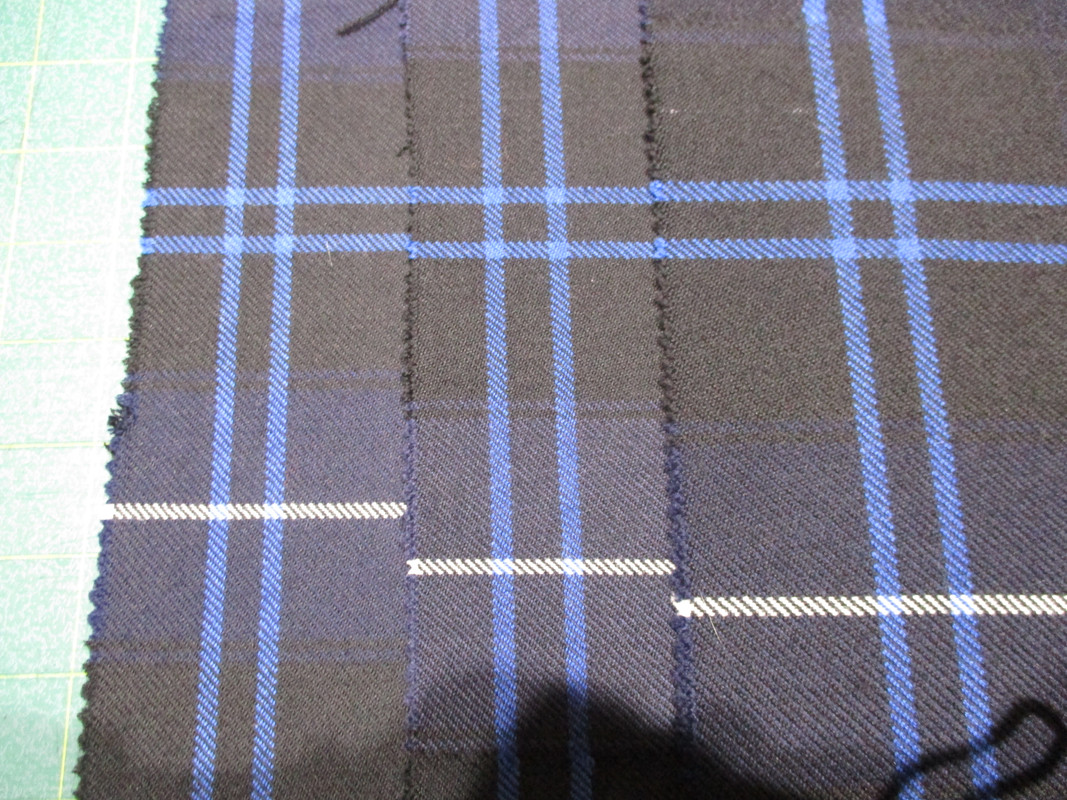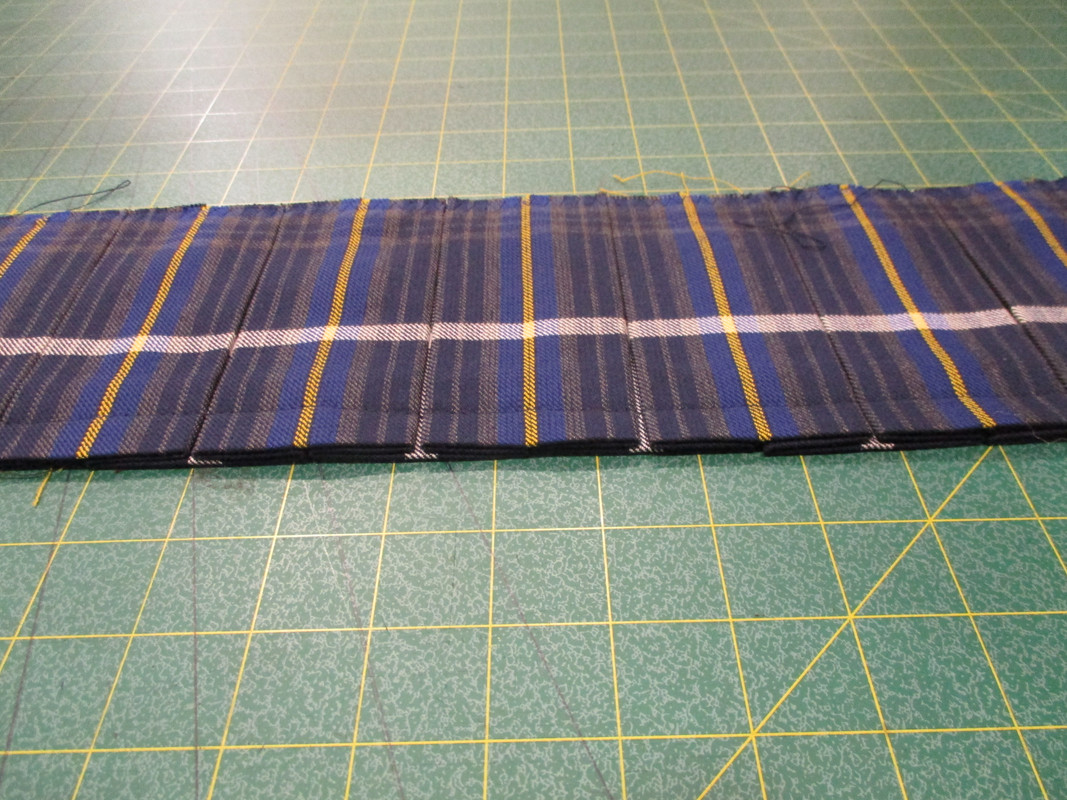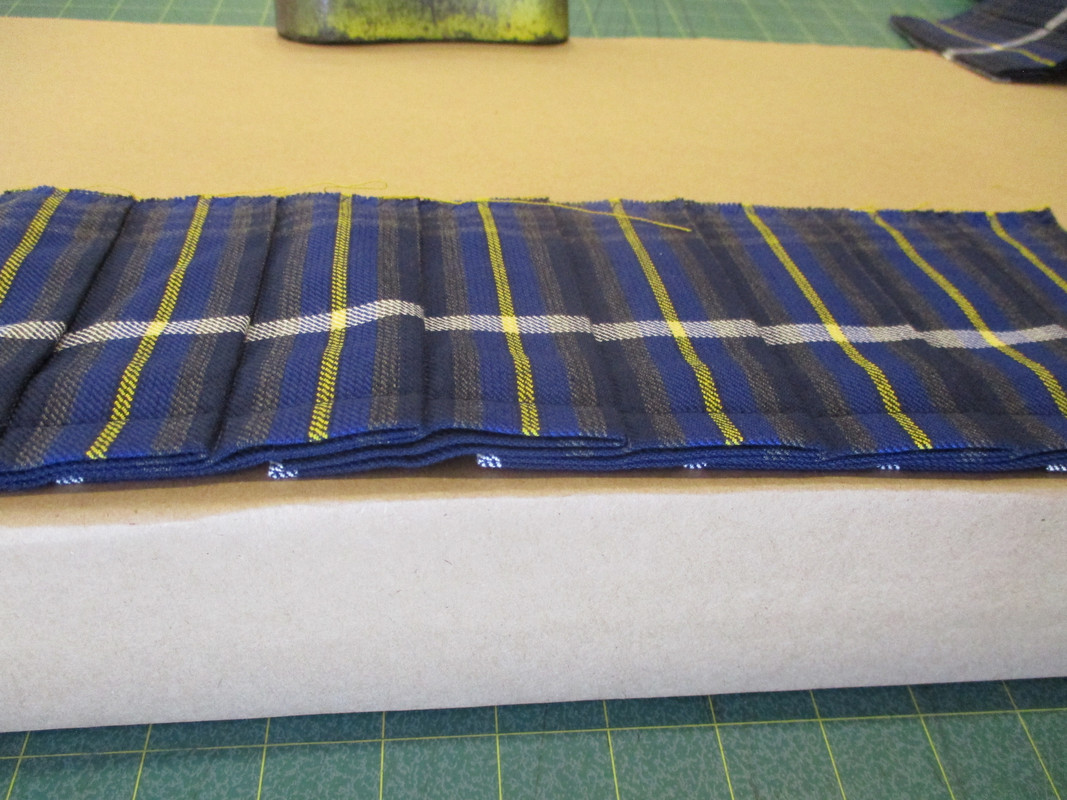|
-
10th March 21, 10:16 AM
#1
Let me try to illustrate using some very basic concepts.
Kilt fabric is sold as weighing a particular amount for a given yardage.
This yardage is usually expressed as ounces per linear yard at "double-width" or as the fabric is woven and sold to the kiltmaker.
A kiltmaker buys fabric double-width, cuts or rips it in half and joins the two halves. For example - to create an 8 yard kilt - a kiltmaker needs only to buy 4 yards of double-width fabric which is cut length wise. The result is an 8 yard long piece with a join in the middle.

If the fabric is listed as "16oz" it weighs 16 ounces or 1 pound for every linear yard @ double-width. So 4 yards of double-width fabric purchased by a kiltmaker will weigh 4 pounds.
But - There are 4 factors which will effect how much fabric will end up in a kilt.
1) The circumference of the customer's hips. The larger the customer is, the more fabric it will take to go around him.

2) The size of the Tartan pattern is called "The Sett". As each pleat will take up at least one repeat of the Tartan pattern, The larger the pattern is - the more fabric it will take to go around the person.

3) In general- the heavier the fabric - the larger the pattern will be in the woven fabric.

4) And finally how the fabric is folded into pleats. Here are two examples. Same fabric just folded differently.
When fabric is folded into Knife pleats there are many layers stacked up - This way of folding the fabric is what is referred to as an 8 yard kilt.

But when the fabric is folded into box pleats there are fewer layers stacked up - This way of folding the fabric is usually referred to as a 4 yard kilt.

We can also vary the width of each individual pleat. Wider pleats mean that fewer pleats will be needed to go around the butt. This is how a 5 yard kilt is made.

And these are just some of the many different factors that can effect just how much fabric is actually needed to make a kilt.
So, with these factors in mind here is a really rough, ballpark method, of determining the weight of the fabric that was used in a kilt.
With a tape measure, find the linear amount of fabric used, by measuring along the bottom edge in inches. Convert to yards to determine if you have an 8, a 5, or a 4 yard kilt.
Then measure the width of the fabric from the top of the waistbanding down to the bottom edge.
In inches.
Multiple the length by the width to determine the total square inches used.
One linear yard of double-width fabric will be 2160 square inches. (36" x 60" = 2160 sq. in)
Divide how many square inches are in your kilt by 2160. This will tell you how many double-width yards are in your kilt.
Let's say for example you measure and find your kilt has 8640 square inches. That is exactly 4 yards of double-width fabric.
Then put the kilt on a postal scale. If your kilt was made from 16oz fabric, your 4 yard double width fabric (8 yard kilt) kilt will weigh 4 pounds.
A full 8 yard kilt made from 13oz fabric will weigh 3.25 pounds.
A full 8 yard kilt made from 10oz fabric will weigh 2.5 pounds.
-
The Following 9 Users say 'Aye' to Steve Ashton For This Useful Post:
-
10th March 21, 01:57 PM
#2
Thanks, Steve! That is about as thorough an explanation as I can see possible. I should definitely be able to answer these questions with my new (to me) kilt.
Dave
-
-
10th March 21, 06:33 PM
#3
I concur with ^. Steve this is an outstanding explanation for new people. Could you make this a sticky?
-
The Following User Says 'Aye' to DCampbell16B For This Useful Post:
-
11th March 21, 09:54 AM
#4
When you hold the material in your hand, you will definitely notice the difference between light, medium, and heavy weight tartan. I have a kilt made of 11 oz fabric and one of 13 oz. It is surprising how much heavier the 13 oz feels than the 11 oz. I'm sure 16 or 18 oz material would be just as noticeably heavier than the 13 oz.
Consider the climate where you live. The more hot and humid the climate, the more I would suggest looking at lighter weight fabrics. The colder the climate, the more you'll want a heavier material wrapped around your body. Living in Florida and now South China, my lightweight kilt is wonderfully cool and practical. When I lived in Beijing, a heavier fabric was very welcome.
The general public will not notice the difference between a 5 or 8 yard kilt. But I can say that the way my 8-yard kilt hangs is far superior to my 5-yard one. The additional fabric and deeper pleats make for more swing and a more refined look overall. But the 5-yarder still looks very nice and I always get compliments on my kilt, no matter which one I am wearing.
Happy kilting!
Andrew
-
-
11th March 21, 07:22 PM
#5
 Originally Posted by kingandrew

When you hold the material in your hand, you will definitely notice the difference between light, medium, and heavy weight tartan.
Consider the climate where you live. The more hot and humid the climate, the more I would suggest looking at lighter weight fabrics. The colder the climate, the more you'll want a heavier material wrapped around your body. Living in Florida and now South China, my lightweight kilt is wonderfully cool and practical. When I lived in Beijing, a heavier fabric was very welcome.
The general public will not notice the difference between a 5 or 8 yard kilt. But I can say that the way my 8-yard kilt hangs is far superior to my 5-yard one. The additional fabric and deeper pleats make for more swing and a more refined look overall. But the 5-yarder still looks very nice and I always get compliments on my kilt, no matter which one I am wearing.
Happy kilting!
Andrew
It seem pretty heavy. It keep trying to slip out of my USA Kilts hanger. It is definitely heaver than the USA Kilts Casual Kilt that it displaced from the hanger.
The kilt is already in my possession. In an earlier post i had some pictures. I was trying to find out what tartan it was. It turned out to be MacDougall. Very attractive IMO. I live in Maryland and it gets cold here, so no problem with a heavy kilt. I've been to Beijing twice, but it was summer and very hot!
The general public definitely doesn't notice around here, but I'm a bit of a perfectionist. Sound like you are too!
Thanks for the reply and Happy kilting to you too!
Dave
-
-
13th March 21, 01:41 PM
#6
 Originally Posted by kingandrew

When you hold the material in your hand, you will definitely notice the difference between light, medium, and heavy weight tartan. I have a kilt made of 11 oz fabric and one of 13 oz. It is surprising how much heavier the 13 oz feels than the 11 oz. I'm sure 16 or 18 oz material would be just as noticeably heavier than the 13 oz.
It wasn't until I bought my second and third kilts (both 13oz wool from Lochcarron) that I realized my first kilt (purchased new but not bespoke for me) is probably an 11 ouncer. The difference in the fabrics is very noticeable. That being said, the fabric on the 11 oz. is very nice, on par with the Lochcarron wool or even nicer. Hangs well, swings well, pleats have held up well. (The maker of that kilt uses Lochcarron and HoE, so could be either one.)
-
The Following User Says 'Aye' to SF Jeff For This Useful Post:
-
9th April 21, 05:04 PM
#7
Thanks all again! I was able to determine, with all of you help and some additional research, that what I have in fact is a Claymore MacDougall, 8 yard, pleat to set kilt. I also did some additional research, and the pleat to set is also different on a 4 and an 8 yard kilt. This one looks more like an 8 yard, but the preverbal nail in the coffin was that Claymore uses 3 straps on the 8 yard and 2 straps on their 4 yard. They also have a 4 yard top stitch, and this is definitely not a top stitch like my acrylic kilts are. I think it is 13 oz. but I will have to wait until I can compare 11 and 13 oz. fabric side by side.
I also have a wool Royal Stewart kilt that I bought at auction that also appears to be an 8 yard. There is no manufacturer but it appears to be really old. It came with a matching pipers plaid (w/ waist belt). One of the more interesting things about it, while not being and ancient or weathered tartan, it is faded on the outside but not the inside, like it was actually weathered, no made to look weather. I will take pictures and make a separate post.
IMG_0107.jpg IMG_0108.jpgIMG_0106.jpg
-
-
13th March 21, 05:42 AM
#8
 Originally Posted by Steve Ashton

3) In general- the heavier the fabric - the larger the pattern will be in the woven fabric
Cheers Steve, you may have solved a little puzzle for me.
I have 4 kilts all in different versions of MacFarlane tartan. Two of which I am sure are Lochcarron and one which (from memory) I think is, the other I have no idea about. However, amongst the 4 there are three different sizes of set - not by much (and not as great a difference as the example you posted) but noticeably so.
From the handle of the cloth, I have always felt that the one with the smallest set is a lightweight tartan (say 11oz). This is the one I have no idea about the mill. My original kilt, which (as far as i can recall - it's over 20 years) is a mediumweight (13oz) Lochcarron tartan is identical to one of the kilts which is certainly from Lochcarron. The puzzle, however, is over my latest addition which has a larger set. I bought it readymade and the maker had confirmed it was Lochcarron cloth - but the set is bigger than my other two and a sample I had ordered. I am now given to understand this is perhaps heavyweight (16oz) cloth.
-
 Posting Permissions
Posting Permissions
- You may not post new threads
- You may not post replies
- You may not post attachments
- You may not edit your posts
-
Forum Rules
|
|


























Bookmarks